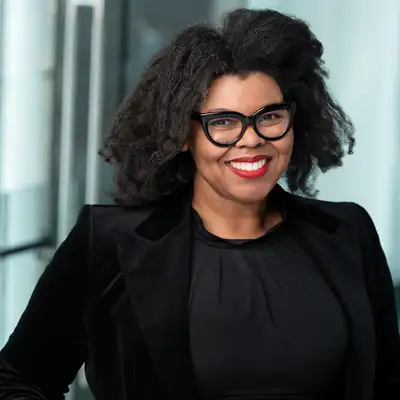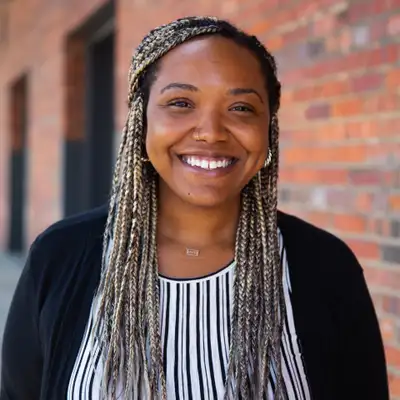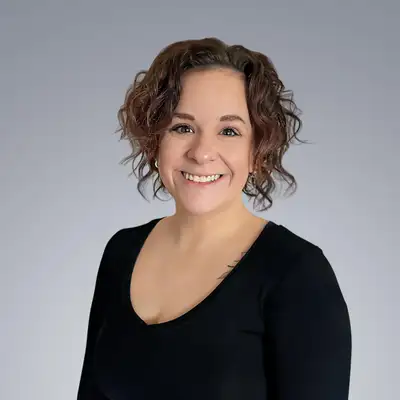Click HERE to view the full consensus study report.
Creators and Guests
What is Transforming Tech: Advancing Innovation Through Inclusion?
You work at a tech company, and you want to do the right thing: You want to hire people from all backgrounds, and you want to make sure your workplace is inclusive. But where do you start? What do you do?
Join entrepreneur, computer scientist, and CEO Jamika Burge in this five-part series from the National Academies of Sciences. Based on research and analysis from the National Academies consensus study “Transforming Trajectories for Women of Color in Tech”, Burge and her guests use design thinking to help engineering and tech companies recruit, retain, and advance women and people of color in their ranks.
Each episode will give you actionable solutions to increase diverse people and perspectives. Inclusion isn’t impossible. Let’s transform tech.
Jamika Burge (00:07):
Managers might put in a lot of work to make sure they hire employees from historically marginalized backgrounds. When they do, they celebrate how truly inclusive their workforce has become. But then when those very employees suddenly move on, those same managers are shocked. After all, they hire them, why didn't they stay?
Jamika Burge(00:37):
Welcome back to Transforming Tech, a five-part series that will help tech companies of every size achieve their inclusion goals. In our last two episodes, we covered the different barriers that women of color in particular might face during the hiring process, and we discussed the actions that managers and companies could take to hire more equitably, by partnering with conferences for women of color, to blind-reviewed resumes and scripted interviews. But the job doesn't end there. It has only begun. In the next two episodes, we're going to talk about problems of retention, why turnover rates might be high, and how to make sure women of color feel comfortable and valued in their roles at your company. My first question for you is, who at a tech company is most responsible for maximizing retention rates?
Marisela Martinez-Cola (01:38):
That's a really great question. It's interesting because a lot of the work happens below, but it's really the people above that really need to happen. So I'm talking supervisors, managers, anybody that has pull to be able to really make a change in the industry itself or in the company itself.
Jamika Burge (01:55):
So we're looking at high-level supervisors, managers, the executive even who are leading from the top down?
Marisela Martinez-Cola (02:03):
Absolutely. Because they're the ones that can really make the changes that are asked for that are requested and sometimes demanded of the employees. So you can do a lot of really great work amongst the employees and the mid-manager physicians. You can really do a lot of great work, but if it doesn't get implemented as part of the structure of the organization, then the efforts are all for not really.
Jamika Burge (02:26):
That's Marisela Martinez-Cola, a sociology professor at Morehouse College. An historically Black college in Atlanta, Georgia. We'll be hearing more from her in a bit. But first, when we talked about bias in hiring, we talked about how companies often like to hire known quantities. Based on who their employees know or institutions they recognize and respect. Once women of color have run that gauntlet, however, and they're in the company, they face even more forms of bias.
Joan Williams (02:59):
There are basically four different kinds of bias that commonly arise, actually five in the workplace if you consider race and gender simultaneously.
Jamika Burge (03:09):
That's Joan Williams. Sullivan professor of law and founding director of the Center for WorkLife Law at the University of California Hastings Law. She's also the founder of Bias Interrupters, a data-driven approach to identifying and combating bias in the workplace. We heard from her in our first few episodes. Williams has made a long study of different types of bias.
Joan Williams (03:34):
The first is called prove it again. Some groups have to prove themselves more than others. Women have to prove themselves more than men. People of color have to prove themselves more than white people. Women of color have to prove themselves at a level of about 25 percentage points higher than white women do, and white women are much higher than white men. So this is a very, very big effect, this prove it again effect. It starts at the beginning and it goes throughout. We've already talked about one example of if you are recruiting chiefly white men or white and Asian men through referrals, you give them a light review because you assume they're competent, whereas the women of color have to cross every T and dot every I. That's a classic prove it again effect.
Joan Williams (04:23):
The second type of bias is called tightrope bias. And that reflects the fact that authoritativeness and assertiveness tend to be readily accepted from white men and seen as evidence of leadership and intelligence but the same isn't necessarily true of every other group. So women who behave in an authoritative way, they may be respected, but often they're not liked. They're seen as abrasive or not a team player. All kinds of B words and dragon lady words, and you name it. Women and especially women of color, but also white women have to be literally politically savvier in order to succeed because they need to not just display authoritativeness, but they need to display authoritativeness in a way that their audiences feel comfortable with.
Joan Williams (05:12):
Another common form of tightrope bias reflects who gets access to career enhancing work. We have data sets for a number of different industries and the number of different organizations, over 20,000 people. And what we signed is that about 80 to 88% of white men say they have fair access to career enhancing work. But the same question for women of color, sometimes only as low as 50% say they have a fair access to career enhancing work. So that is another tightrope effect that has profound effects when it comes to promotion and retention. I thought maternal wall bias is gender bias triggered by motherhood. It's the strongest form of gender bias. It's very, very strong and very, very strong in tech. We have constant reports that once you have children, you're seen as not having quite the fire in your belly that you once had, and it's harder to get the good work.
Joan Williams (06:14):
Then tug of war is when bias against a group fuels conflicts within a group. And for example, sometimes when a person of color advocates for another person of color, that's seen as favoritism rather than as really a discussion of merit. That rarely happens to white men, but it's quite frequent for women of color. So these dynamics set women of color off against each other within a workplace. And then finally, of course, women of color, like men of color face shockingly high levels of reported gender stereotyping and bias.
Jamika Burge (06:53):
These biases end up shunting traditionally marginalized groups, particularly women of color into specific roles in the workplace, roles that often we don't want to do and which don't get valued or rewarded.
Joan Williams (07:08):
We've done two reports actually on women in engineering, this pinning down the jelly fish report on women of color in tech earlier report on engineers nationwide, which we did in partnership with the Society for Women Engineers. And in both reports we find women very often doing what we call the office housework. The office housework is really four really different things. First, sometimes it's literal housework. I mean being expected to clean the cups in a startup for example, or in a larger company being in charge of team building exercises like baby showers and stuff. The second is administrative work. Who takes the notes and who finds a time to meet? We actually had one woman saying that although she was higher in rank than any of the men in the meeting, she literally had to pull over her car because her manager assigned her to take notes at the meeting. That's really, really common. Of course, everybody who's junior ends up doing that administrative work.
Joan Williams (08:18):
But what often happens is that white men actually, this is just a gender effect, so all men seamlessly cycle out of it, but that women find it really hard to shed. So again, they're having to work twice as hard to get half as far. The third is something that actually was really big under COVID, which is being expected to play traditionally feminine roles to comfort people, to be the peacemaker, to be the office mom who takes care of everybody else but is undemanding for herself. Or another common role is the dutiful daughter who aligns a powerful man and does all of his scut work and he gets the glory and she gets the scut work. And finally there's just whatever is the trains running, undervalued work that has to be done but doesn't typically lead to promotion.
Joan Williams (09:11):
In some engineering companies, and these were typically not tech companies, they were more aerospace and the such engineers who built stuff sort of companies doing the quality control work was seen as had to get done, wasn't going to really be a step stone to promotion. There are certain roles in checking the code that are often this undervalued work in tech companies and women do wildly more of this than men do.
Jamika Burge (09:44):
There's another piece of undervalued work that women of color constantly end up doing, work that is undervalued and unpaid. It's the work around inclusion itself.
Marisela Martinez-Cola (09:57):
Often what ends up happening is the person of color that gets hired ends up becoming the DEI person in that company. Because they're either the only or one of a handful. That's usually how it works. So they become all things DEI. And when they're never compensated for it, never compensated for it. And this is extra work above the work they're already doing in an expertise by the way that they may not necessarily have. So I think that one of the things to realize is that some of that work has to be done internally, but it's not the responsibility of that one person that you've hired to be able to now educate everybody else. Because Again, it can be really exhausting, hence racial battle fatigue.
Jamika Burge (10:39):
That DEI work takes up valuable time and energy for women of color. Energy that they would've otherwise spent pursuing professional opportunities, taking on glamour work that is appreciated or valued for promotion and improving themselves and the company.
Marisela Martinez-Cola (10:56):
And I think that if they don't allow people to go and learn more and better themselves, then how is the company going to improve? And again, appealing to people's greed. People come back with ideas that can only help make the company better and they get excited about it. And I think that that's something that is really, really crucial is to be able to feed that excitement. Because what happens is that excitement gets starved. It's so interesting because sometimes some of this work, some of this DEI work, I tell people DEI can sometimes make you D-I-E.
Jamika Burge (11:30):
Wow, I'm still stuck on the DEI can make us D-I-E. But even if it doesn't make us D-I-E, it can certainly kill our enthusiasm, make us want to move on or feel that we aren't doing the work we got hired for. And the biases don't stop there. There are also sources of bias in what women of color are hired for in the first place. Whether they are hired for contract work or full-time work.
Rocio Van Nierop (11:57):
Say Google is over 50%. 50% of your staff of the headcount that you have are contingent workers. That means they have no benefits, they're hired like as temporary workers, part-timers.
Jamika Burge (12:09):
That's my friend Rocio Van Nierop, the CEO and co-founder of Latinas in Tech. And she notes companies often hire people from traditionally marginalized groups for contingent positions.
Rocio Van Nierop (12:22):
I'm talking about UX researchers, engineers. I'm not talking about the bottom of the bottom. Okay all of those are contingent workers. They don't have the same benefits for a one-day savings, retirement savings, maternity leave, unlimited PTO and all those things. They don't have it. Half of the people in those companies don't have it. They have other agencies caring for them. So in contingent workers, they're not allowed to measure diversity. So then if you don't know what they are, how could you cater for them? Because you do have them in the office spaces and in your lounge rooms and when they say, "Oh yeah, I'm going to go for maternity leave," and then the Latina is like, "I don't have that." So many companies employ and they add them. Do you think the contingent workers look the same as the full-time workers? And they say, "Well, no. They tend to be Black and brown." But they're not going to tell you those numbers. They're going to say, I don't know those numbers. I'm not allowed to ask.
Rocio Van Nierop (13:12):
Okay, so here's the thing. If you're contingent, you cannot be promoted, you cannot be hired, you cannot get a raise or even if you get empowered to make a difference, they cannot give it to you. Not legally it's not illegal, but their lawyers will say, "Just don't offer it because we're not going to go through that liability."
Jamika Burge (13:28):
We'll be hearing a lot more from Van Nierop in future episodes. But she's right. Often, women of color are hired on the side, part-time in ways they make sure they don't get value the way they should. And if you can't value an employee, how can you retain them?
Jamika Burge (13:45):
All right. We've talked about the different ways that bias can appear in the workplace and how those biases, most of them unconscious, can leave women of color doing work that doesn't satisfy them, train or upskill them or fully utilize their skills. How should managers and companies fix this? We've defined the problem, now it's time to design, think, a way out of it. One answer to this is asking the women of color in your company if they feel supported. And if they don't, what would help? It can be a hard vulnerable thing to ask. You might hear some things that don't make you feel great, but it is essential if a company wants to make sure it retains the talent of its women of color. It's time for a 360 review.
Marisela Martinez-Cola (14:40):
Very times supervisors evaluate their employees, but the employees never get a chance to evaluate their supervisors and to be able to say, "This is where you need to grow as a supervisor." They're going to have a perspective of you that you as a supervisor are just not going to have. So if you can do a 360 evaluation to be able to get the impression for everybody, then you're going to be able to see those spots where there's individuals that are just not safe.
Jamika Burge (15:06):
What does safety mean in this context? It could mean that the employee is experiencing microaggressions or even very obvious bias. It could mean that the employee is not getting the exciting, rewarding work that makes them and the company grow. No matter what, you cannot know unless you ask.
Marisela Martinez-Cola (15:27):
Ask them. You want to know how to change it, ask them. They'll tell you. And then ask them but implement it. When you just ask, and if it feels, yeah, you feel special because you're being asked. But if there's no substance of change that comes of it, then what's the... The best DEI strategies that I've seen again have been top down DEI strategies where you actually see substantive changes happening at a leadership level. More than just having a VP of diversity, for example. What does that mean? There's something substantive that there's something measurable, something you need to be able to...
Jamika Burge (16:01):
This is another important point. 360 reviews, surveys, all of these methods generate data. And you know how much I love data.
Marisela Martinez-Cola (16:11):
I think that the effective DEI strategies have a level of some measurement. Either before or after or some are valued with process because unfortunately, a lot of the DEI efforts aren't working. They end up just making people more exhausted.
Jamika Burge (16:29):
Data can be a huge help in finding out where DEI efforts succeed or fail. But when women of color are so underrepresented in tech, managers and companies might worry about making that data public. If there's only one woman of color in your department, it's going to be awfully easy to find out who wrote a review about microaggressions against women of color. The solution would seem to aggregate the data, but it's not so simple. You mentioned the term measured, so I can't not ask you about data and data aggregation. What is data aggregation and why is it problematic in this context of supporting women of color in the workplace?
Marisela Martinez-Cola (17:17):
One of the things that there's the stereotypes that are out there, is that Asian people are the most successful. So Asian people are the most successful and then you start to look, they make this much, they have these jobs, blah, blah, blah, so and so forth. So whenever somebody tells me that and talks about that, I always ask them, "Which Asians are you talking about?" Because when you disaggregate the data, you're going to get a very different story and you're going to see that East Asian experiences are different than Southeast Asian experiences are different from experiences of people that are foreign born versus people that are born outside of the country versus people that are born inside of the country. You need to really be able to get all that. But if you get it, if you put them all in one pot, of course it's going to look like that.
Marisela Martinez-Cola (18:00):
I think they almost have this idea of a melting pot idea when it comes to collecting data. They're still very much in the melting pot idea rather than the mixed salad. And it's trite, but it's a mixed salad approach where you're able to really look fundamentally at each individual component of your company, not just collected. Because my experiences as a Chicana are going to be very different, absolutely different than your experiences as a Black woman. And I think that you need to be able to get to those stories and experiences and find the critical connections, but also the meaningful differences.
Jamika Burge (18:36):
But some companies might be nervous about disaggregating that data, and claim that they want to protect their employees' privacy. But who really is being protected?
Mia Ong (18:49):
I would say read our National Academies report and you will see all the reasons why disaggregated data are necessary and needed.
Jamika Burge (19:01):
That's my friend, Mia Ong, senior research scientist at TERC, T-E-R-C. A STEM education research and development organization. She's also the author of The Double Bind in Physics Education, a 2023 book that follows women of color in STEM through their scientific careers. Documenting the challenges they face that are specific to women of color in STEM spaces, including tech. Ong has heard fears about disaggregation many times, but notes that often when companies don't want to disaggregate their data, it's because they want to protect themselves, not their employees.
Mia Ong (19:40):
It's impossible to give a true read of the number of women of color in tech, because many tech companies report their numbers in aggregate. And they do this either in their own firms or they do this in conjunction with other companies. And they do this under the guise of protecting the confidentiality of their workers. But in most instances, they are covering up a lack of diversity and a lack of hiring that should expand to include more women of color as well as other minoritized populations. And if what I tell them is if you're a leader in one of the companies not reporting disaggregated data, ask yourself why you're doing it. Why are you covering up both retention failures and retention successes of the women of color who've come through.
Mia Ong(20:28):
And disaggregation of demographic data is something they say, "Oh, well, we're just protecting the women of color." That is what women of color want in their employment data. Will I come in and be one of the only? Will I come in and be supported? Will I have mentors that look like me? And if you are the only woman of your particular race or ethnicity, guess what? You already know it. How are you being protected?
Jamika Burge (20:54):
Not only does hiding these data fail to protect women of color, it also fails to recognize their extraordinary achievements.
Mia Ong (21:03):
And there was a woman who was a Black female biologist and she was very senior, and she said, "Do you know how many black females got their PhDs in 1970 whatever, in biology? There was one. It was me. And I was really, really proud of that and I want everyone to know, and everybody did know." And there is no escaping that.
Jamika Burge (21:26):
So are there times then where it makes sense to disaggregate the data and other times where you want to aggregate it and how do you know when to do either?
Mia Ong (21:39):
Absolutely. There are times that aggregation or protection is really important. It's vital in fact. One of those is when you are taking a cultural climate survey on your workplace experience. It's very different from, am I here or am I not here? Because a climate survey collects how you feel about your work, about the people around you, about the relationships you have in your workplace. And those who are minoritized, including women of color, who put their experiences down in a survey, are in the spirit of helping the organization. Make themselves vulnerable if their identities are known. I would say the difference is demographics versus surveys odd experience, data collected on experiences.
Jamika Burge (22:34):
So if we're thinking about women of color in particular at a particular organization, institution, or company, how do you get around the problem of attribution? That is figuring out who gave what feedback so that folks don't have to be afraid of retribution or for someone coming for them or calling them woke or whatever other word they might use to really reflect a lack of understanding of that experience. So what to do about attribution for women of color in particular?
Mia Ong (23:12):
So one is to hire somebody who is external to the organization who has the right training as a researcher or evaluator to protect those who are being spoken to. Because it makes it less risky if you have somebody who is outside. So that is one option. Another option is to simply ask permission either in the survey or whatever form of data collection you have, or to return to them after the fact and say, "We would love to use this quote in our with attribution. Do we have your permission?"
Jamika Burge (23:49):
A novel idea there, ask. Like ask, just ask for permission, ask the question, and it opens up a whole other line of communication. Data can often reveal uncomfortable truths. Once your company has collected and disaggregated data about workplace environment and culture, you might find yourself reckoning with ideas that may make you deeply upset. It's easy to get defensive. After all, your company is a success. You've hired people of color, you've done your due diligence and taken the data.
Mia Ong (24:29):
So there are many myths about committing to a more diverse workplace. And one of those myths is this phrase, go well, go broke. And I saw it on the headlines. CEOs were saying it. I know that research does not support this thought process and in fact just the opposite is true. Research supports a diverse workplace for outcomes of product innovation, creativity, recruitment and design, and ideate a diverse workforce. Diverse teams provide the best possible outcomes. We know this. We've known this for years and we have research to back that up.
Jamika Burge (25:11):
This is not an attack. It is an opportunity. An opportunity to make the workplace a better place for everyone. Say your company gets its data on how women of color are faring in the workplace. You find out how different people in the company are spending their time and you find bias. You find that women of color are doing that office housework.
Joan Williams (25:34):
So for any of those things like certainly literal housework and also administrative work, you need to set up a rotation so that everyone at a certain level trades this off. And then one pattern we often find is that even where you have a rotation or where men are asked to do this, very often they do it poorly because they know that it's a dead end, and they're not dinged for doing it poorly. So they're just never given it again.
Jamika Burge (26:03):
Don't just put the housework on rotation, put it on rotation, and make it clear that this is as much a part of being at the company as any other type of work. Reward people who do it properly.
Joan Williams (26:18):
What we found is that once people begin to keep these metrics, they really move change because some of these things... A lot of this is like mushrooms and only thrives in the dark. Once you see that 80% of the white men think they're getting fair access to career enhancing work but only 50% of the women of color do, kind of hard to argue with that.
Jamika Burge (26:41):
Once you have that data, you have evidence of what needs to change and often ideas on how to change it. Here are our takeaways. First, biased practices and inefficiencies that leaders don't realize are present can make it difficult or downright impossible for women of color to stay in their jobs. They don't find their work valued and often get stuck doing work that prevents them from developing themselves professionally. Second, there are four major kinds of bias in the workplace that can lead to problems with retention. That bias shows up in the roles that women of color end up playing in the workplace, roles for which they were not hired.
Jamika Burge (27:31):
Third, getting real honest feedback from your employees can help companies find where their problems are. Identifying those biases shows managers not only what problems need to be solved, but how to solve them. Some of that data needs to be disaggregated for the company to understand where the problems lie. Fourth, it's up to management to drive these changes forward, to demand the data, and to question biases. Next time, we're digging more into the topic of retention by coming to grips with workplace culture. What is it? Where can it be a problem? And how do companies create workplace cultures that see and value all of their employees?
Jamika Burge (28:33):
This podcast, Transforming Tech, has been a production of the National Academies of Sciences, Engineering, and Medicine, the National Academies Press and Voxtopica Productions. Its contents are based on the National Academies 2022 Consensus Study Report, Transforming Trajectories for Women of Color in Tech. A publication of the Committee on Addressing the Underrepresentation of Women of Color in Tech, the Committee on Women in Science, Engineering and Medicine and Policy and Global Affairs. This podcast was developed, written, and created by Voxtopica Productions. Our executive producer is Richard Fawal. Our producer is Laura Krebs. Direction and scriptwriting by Bethany Brookshire. With help from Cassidy Butler. Technical Operations from Ismael Balderas Wong, and Reese Clutter. Project assistance from Alya Fawal. I'm Jamika Burge.
VO (29:35):
Voxtopica.












